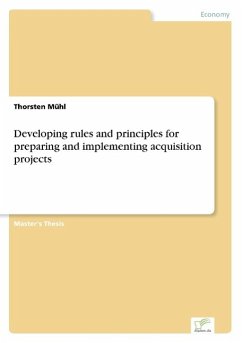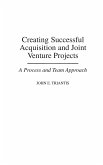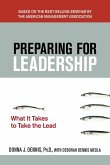Master's Thesis from the year 2001 in the subject Business economics - Business Management, Corporate Governance, grade: 1,0, University of Applied Sciences Mainz (Wirtschaftswissenschaften, General Management), language: English, abstract: Inhaltsangabe:Abstract:
Near the beginning in Homer s Odyssey, the son of Odysseus, young Telemachus, had been advised by the goddess of wisdom, Athena, to ask old King Nestor about an important issue, relating to the residence of his father. Telemachus hesitated, explaining his doubts by introversion and insecurity. Telemachus behaviour lives on in the contemporary context of Mergers &Acquisitions where still the most inexperienced, unskilled professionals supposed and expected to know everything long before the process starts. Developing rules and principles for preparing and implementing acquisition projects attempts to provide a general idea about one of the most difficult, vast, complicated, and sometimes immeasurable growth strategiesin management, M&A. While M&A activity had been an Anglo-American occurrence during the first merger wave, the process of concentration had changed to a global phenomenon. Financially driven acquisitions and corporate raiders had been popular during the 1980s, the 1990s and the present is faced with strategic M&A.
The present research focuses especially on points that are problematical to measure. Part one comprises a basic approach to M&A, including corporate strategy in terms of its characteristics and the element of strategic management.
Part two of the thesis is concerned with the entire M&A strategy. Therefore, the acquisition process had been divided into three components:
1. Pre-acquisition process.
2. The transaction-phase.
3. Post-merger Integration Management (PIM).
The centralisation of this part and also the whole thesis, is the search and screen process for potential target companies, a marketing and cultural due diligence approach, and the post-merger integration management (in particular the integration of different organisational cultures). To be precise, the author considered these aspects as absolutely elemental, unquestionable and critical for M&A success.
As a result, point four (Valuation techniques and financing methods) is only explained incredibly superficial.
The final part of the present research - Part three - combines all the various aspects that had been evaluated during the study by providing some guiding principles for M&A success.
Furthermore, the terms Mergers and Acquisitions are used interchangeably in the text because in many instances it is not clear whether one or the other is occurring. However, for certain purposes, it is necessary to distinguish the two forms of business combinations. The distinction has been explained to greater detail in 2.2.
The field of M&A is far too extensive to be covered thoroughly within a limitation of approximately 60 pages. In order to treat M&A entirely, research has to focus not only on economical aspects but also on sociological and psychological issues. The objective of the thesis was to give a wide-ranging view about the challenging topic and provide, as a general principle, some rules for preparing and implementing acquisition projects. For that reason, the appendices are designed to present practical information on a how to do basis.
Finally, I would like to thank those who have contributed to the study by providing information and constructive comments and improvement proposals. In particular, I would like to thank my aunt, Madame Gisèlle Hierse, whom I engaged in correcting the spelling and grammar mistakes in this paper. Further on, I would like to thank my supervisor, Professor Dr. Herbert Paul, who always had been centrally involved. His guidance, and encouragement is truly appreciated.
Inhaltsverzeichn...
Hinweis: Dieser Artikel kann nur an eine deutsche Lieferadresse ausgeliefert werden.
Near the beginning in Homer s Odyssey, the son of Odysseus, young Telemachus, had been advised by the goddess of wisdom, Athena, to ask old King Nestor about an important issue, relating to the residence of his father. Telemachus hesitated, explaining his doubts by introversion and insecurity. Telemachus behaviour lives on in the contemporary context of Mergers &Acquisitions where still the most inexperienced, unskilled professionals supposed and expected to know everything long before the process starts. Developing rules and principles for preparing and implementing acquisition projects attempts to provide a general idea about one of the most difficult, vast, complicated, and sometimes immeasurable growth strategiesin management, M&A. While M&A activity had been an Anglo-American occurrence during the first merger wave, the process of concentration had changed to a global phenomenon. Financially driven acquisitions and corporate raiders had been popular during the 1980s, the 1990s and the present is faced with strategic M&A.
The present research focuses especially on points that are problematical to measure. Part one comprises a basic approach to M&A, including corporate strategy in terms of its characteristics and the element of strategic management.
Part two of the thesis is concerned with the entire M&A strategy. Therefore, the acquisition process had been divided into three components:
1. Pre-acquisition process.
2. The transaction-phase.
3. Post-merger Integration Management (PIM).
The centralisation of this part and also the whole thesis, is the search and screen process for potential target companies, a marketing and cultural due diligence approach, and the post-merger integration management (in particular the integration of different organisational cultures). To be precise, the author considered these aspects as absolutely elemental, unquestionable and critical for M&A success.
As a result, point four (Valuation techniques and financing methods) is only explained incredibly superficial.
The final part of the present research - Part three - combines all the various aspects that had been evaluated during the study by providing some guiding principles for M&A success.
Furthermore, the terms Mergers and Acquisitions are used interchangeably in the text because in many instances it is not clear whether one or the other is occurring. However, for certain purposes, it is necessary to distinguish the two forms of business combinations. The distinction has been explained to greater detail in 2.2.
The field of M&A is far too extensive to be covered thoroughly within a limitation of approximately 60 pages. In order to treat M&A entirely, research has to focus not only on economical aspects but also on sociological and psychological issues. The objective of the thesis was to give a wide-ranging view about the challenging topic and provide, as a general principle, some rules for preparing and implementing acquisition projects. For that reason, the appendices are designed to present practical information on a how to do basis.
Finally, I would like to thank those who have contributed to the study by providing information and constructive comments and improvement proposals. In particular, I would like to thank my aunt, Madame Gisèlle Hierse, whom I engaged in correcting the spelling and grammar mistakes in this paper. Further on, I would like to thank my supervisor, Professor Dr. Herbert Paul, who always had been centrally involved. His guidance, and encouragement is truly appreciated.
Inhaltsverzeichn...
Hinweis: Dieser Artikel kann nur an eine deutsche Lieferadresse ausgeliefert werden.








